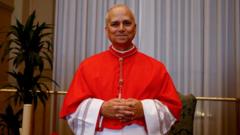The conclave to elect a new pope resumes amid heightened anticipation with reports of more black smoke indicating a lack of consensus among the cardinals.
Awaiting a New Papacy: The Vatican Conclave Entering Its Second Day

Awaiting a New Papacy: The Vatican Conclave Entering Its Second Day
Cardinals struggle to reach a consensus as black smoke signals continued indecision in their search for the next Pope.
Black smoke billowing from the Sistine Chapel this Thursday signals another inconclusive vote among the 133 cardinals gathered to select the next pope. Following a day of higher-than-expected anticipation, the conclave will require more deliberation as it continues today.
Yesterday’s first ballot extended for over three hours, concluding with a long wait for black smoke to emerge from the chapel chimney, much to the dismay of the expectant crowd in St. Peter’s Square. The attendees, comprised of locals and international visitors, collectively sighed upon seeing the black smoke, indicating that none of the candidates achieved the necessary two-thirds majority.
The selection of a pope is an intricate process steeped in history. This conclave, the first since the passing of Pope Francis, marks a pivotal moment, with the cardinals held in a climate of uncertainty, hovering amidst the church’s ongoing ideological divisions. With vocal factions on both sides of the spectrum—progressives seeking reform and conservatives advocating for preservation of traditions—the complexities of the decision-making process are being keenly felt.
Experts suggest that this conclave could take longer than previous elections due to the unique dynamics among the cardinals, many of whom were appointed by Pope Francis and are unfamiliar with one another’s political stances. As they engage in their second day of voting, a lunch break provides a critical pause for reflection before they reconvene.
The conclave process, dating back centuries, has seen myriad changes. Ordinarily, the cardinals will proceed to vote twice daily until a candidate garners sufficient support. Each round concludes with the burning of ballots, but the ongoing black smoke suggests a prolonged deliberation that has become commonplace in papal elections.
What’s at stake is not just the next leader of the world’s 1.4 billion Catholics but the direction the Catholic Church will move in during the years to come—a delicate interplay of tradition and modernization. The intently watched signals of black smoke continue to underscore the challenge in bridging these divergent paths toward unity.
As the hours of decision-making drag on, Sunday’s outcome remains uncertain, with crowds waiting in hopeful anticipation for white smoke, the traditional sign that a new pope has been elected.
For now, the world watches as history is in the making once again inside the Vatican walls.
Yesterday’s first ballot extended for over three hours, concluding with a long wait for black smoke to emerge from the chapel chimney, much to the dismay of the expectant crowd in St. Peter’s Square. The attendees, comprised of locals and international visitors, collectively sighed upon seeing the black smoke, indicating that none of the candidates achieved the necessary two-thirds majority.
The selection of a pope is an intricate process steeped in history. This conclave, the first since the passing of Pope Francis, marks a pivotal moment, with the cardinals held in a climate of uncertainty, hovering amidst the church’s ongoing ideological divisions. With vocal factions on both sides of the spectrum—progressives seeking reform and conservatives advocating for preservation of traditions—the complexities of the decision-making process are being keenly felt.
Experts suggest that this conclave could take longer than previous elections due to the unique dynamics among the cardinals, many of whom were appointed by Pope Francis and are unfamiliar with one another’s political stances. As they engage in their second day of voting, a lunch break provides a critical pause for reflection before they reconvene.
The conclave process, dating back centuries, has seen myriad changes. Ordinarily, the cardinals will proceed to vote twice daily until a candidate garners sufficient support. Each round concludes with the burning of ballots, but the ongoing black smoke suggests a prolonged deliberation that has become commonplace in papal elections.
What’s at stake is not just the next leader of the world’s 1.4 billion Catholics but the direction the Catholic Church will move in during the years to come—a delicate interplay of tradition and modernization. The intently watched signals of black smoke continue to underscore the challenge in bridging these divergent paths toward unity.
As the hours of decision-making drag on, Sunday’s outcome remains uncertain, with crowds waiting in hopeful anticipation for white smoke, the traditional sign that a new pope has been elected.
For now, the world watches as history is in the making once again inside the Vatican walls.






















